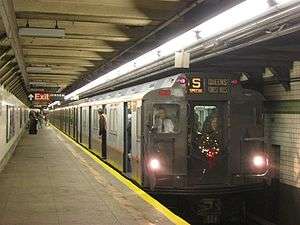R7/A (New York City Subway car)
| R7/A | |
|---|---|
 An R7 car at the Seashore Trolley Museum | |
|
Interior of R7A car 1575 | |
| Manufacturer | American Car and Foundry, Pullman Standard |
| Built at | Chicago, Illinois, USA |
| Family name | Arnines |
| Constructed |
|
| Entered service | 1938-1939 |
| Scrapped | 1978-1979 |
| Number built |
250
|
| Number preserved | 2 (1 R7, 1 R7A) |
| Number scrapped | 248 (149 R7s, 99 R7As) |
| Formation | motorized single units (Half-width operator's cab at each end; conductor controls on exterior) |
| Fleet numbers |
|
| Capacity | 56 (seated) |
| Operator(s) | New York City Subway |
| Specifications | |
| Car body construction | Riveted steel |
| Car length | 60 feet 2 1⁄2 inches (18.35 m) over anticlimbers |
| Width | 10 ft (3.05 m) |
| Height | 12 feet 1 5⁄8 inches (3.70 m) |
| Platform height | 3.76 ft (1.15 m) |
| Doors | 8 sets of 45 inch wide side doors per car |
| Maximum speed | 55 mph (89 km/h) |
| Weight | 84,556 lb (38,354 kg) (ACF), 84,750 lb (38,440 kg) (Pullman), #1575: 82,340 lb (37,350 kg) |
| Traction system | Westinghouse 570-D5 or General Electric 714-D1, 714-D2 |
| Power output | 190 hp (142 kW) |
| Electric system(s) | 600 V DC Third rail |
| Current collection method | Contact shoe |
| Braking system(s) | WABCO Schedule AMUE with UE-5 universal valve, ME-23 brake stand, and simplex clasp brake rigging. WABCO D-3-F air compressor |
| Coupling system | WABCO H2A |
| Track gauge | 4 ft 8 1⁄2 in (1,435 mm) |
The R7 (and R7A) was a New York City Subway car model built from 1937 to 1938 for the city-operated Independent Subway System by two manufacturers under separate orders, the American Car and Foundry Company and Pullman Standard. These cars were a continuation of the R6 fleet.
History
On March 5, 1937, the New York City Board of Transportation opened up bids for 150 cars to be built under the R7 contract. The winning bid for $40,375 per car was jointly submitted by the American Car and Foundry Company (ACF) and Pullman Standard. The Pressed Steel Company also submitted a bid, for $40,850 per car.[1] On July 27, 1937, it was announced that the winning bid for 100 additional cars, under contract R7A, went to ACF and Pullman for $41,951 per car. Additional bids were made by Pressed Steel ($42,200) and Bethlehem Steel ($43,100). The increased in price per car was attributed to strikes in the steel industry.[2]
The R7s were built in 1937, and the R7As were built in 1938.[3][4]
Together, the R7/As provided additional cars for expanded service in Queens and for the opening of the IND Crosstown Line. They were used for service on the IND exclusively until 1968 or 1969, when they were displaced from the IND by the new R40s and R42s and transferred to the East New York Yard.
Many R7/As were replaced by the R44s. Most other cars ran on the Eastern Division until 1977, when they were finally replaced by the R46s.
Preservation

R7 car 1440 has been preserved by the Seashore Trolley Museum in Kennebunkport, Maine. It was modified with trolley poles and is used in various tourist rides around the museum, often coupled to R4 car 800.
R7A car 1575 has been preserved by the New York Transit Museum. It was restored to operating condition and has been used in excursions sponsored by the Transit Museum since 2003. During its service life, it was rebuilt from its original appearance by ACF in 1947 following an accident in 1946, and became the prototype for the R10. It was designed to test new interior and cosmetic features. While it cosmetically resembles an R10, mechanically and electrically it is still an R7A and can only operate with other pre-war IND Arnines.[5][6]
References
- ↑ "Subway Car Bids Opened". The New York Times. March 6, 1937. ISSN 0362-4331. Retrieved October 29, 2017.
- ↑ "$41,951 FOR SUBWAY CAR; $1,575 Advance in Bid to City Is Laid to Steel Strike". The New York Times. July 28, 1937. ISSN 0362-4331. Retrieved October 29, 2017.
- ↑ "Independent Fleet". google.com.
- ↑ Cunningham, Joseph; DeHart, Leonard O. (1993). A History of the New York City Subway System. J. Schmidt, R. Giglio, and K. Lang.
- ↑ https://www.nycsubway.org/wiki/The_Independent_Fleet_(1932-1939)#Car_Notes
- ↑ https://www.nycsubway.org/perl/caption.pl?/img/cars/sheet008a-r7a-1575.jpg
Further reading
- Sansone, Gene. Evolution of New York City subways: An illustrated history of New York City's transit cars, 1867-1997. New York Transit Museum Press, New York, 1997 ISBN 978-0-9637492-8-4